Shih Tzu Eye Problems
by Janice Jones |Last Updated 05-05-2021
Shih Tzu Eye Problems can cause irritation, discomfort and even blindness to your sweet Tzu. Even though the list of problems is long, don't let that scare you. With the proper care and good breeding, your dog many never suffer from any of them.
On the other hand, as a Shih Tzu owner, owner to be or even owner wannabe, a good understanding of the different problems that can plague your dog's eye can be enlightening.
In this article, we will look at the many different problems that can occur in this breed. You may also want to check out our article on Shih Tzu eyes to better understand how to care for your Tzu's eyes.
One of the most spectacular physical features of a Shih Tzu is his eyes--dark and round, and almost human-like. When my Shih Tzu dogs look me in the eyes, it almost feels as though they can see straight through to my soul. I try to do everything possible to protect that gaze. Sadly, that is not always possible as you will see below.
Shih Tzu Eye problems are usually never fatal and even blind dogs can live out a relatively normal life.
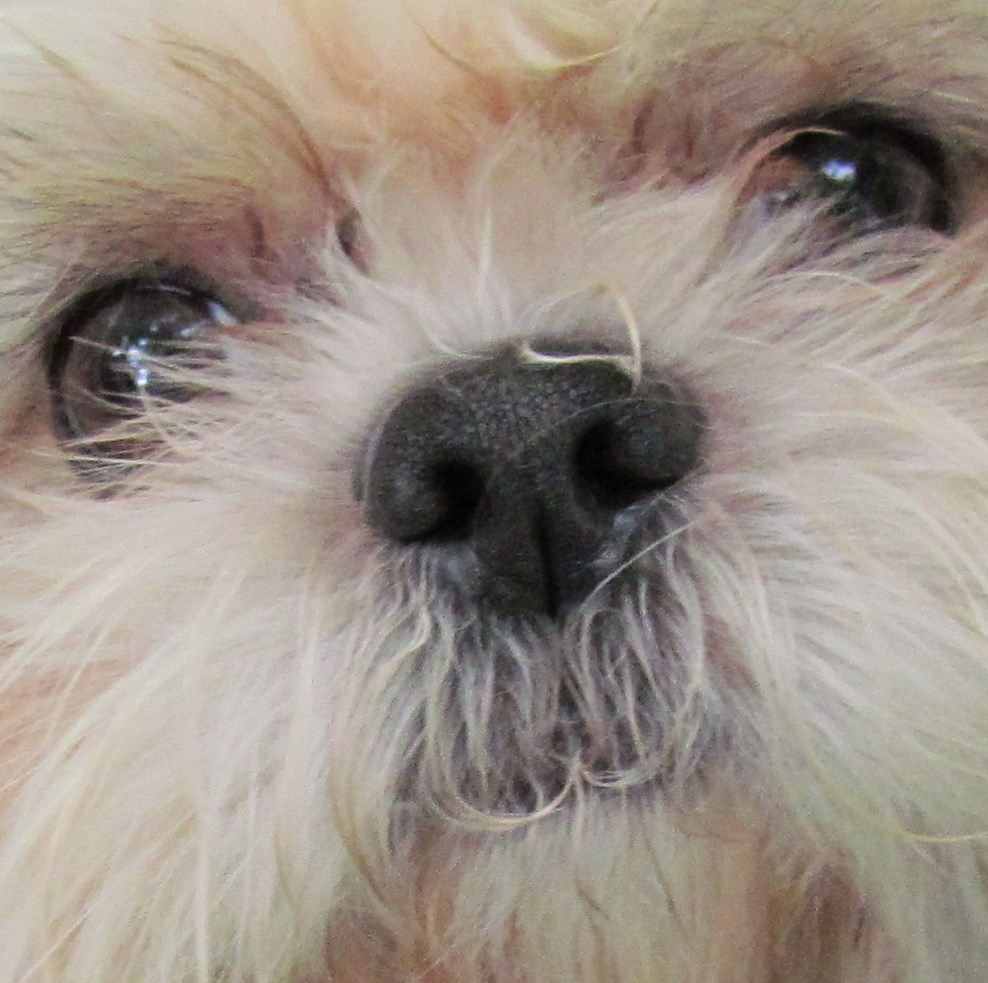 Shih Tzu Eye Problems
Shih Tzu Eye ProblemsAny dog has the potential to develop genetic health problems just as people do. Even with both parents free of a disease, an offspring can inherit the tendency later in life.
Many of the Shih Tzu eye problems listed below are very common in most small breed dogs, and those breeds that have prominent eyes such as seen in the Shih Tzu Breed. Some Shih Tzu eye problems have a genetic basis but others are the result of constant irritation and trauma.
Shih Tzu eye problems are likely to create discomfort to your dog and a drain on your pocketbook. Some can be treated by your local veterinarian, but many require the services of a veterinary specialist.
Causes of Shih Tzu Eye Problems
Probably the most common of all the health concerns is those associated with the eyes. This breed like others with more pronounced, protruding eyes in relation to the skull are prone to many different problems.
Eye infections are one of the more common Shih Tzu eye problems because the Shih Tzu has large eyes and shallow eye sockets.
Foreign materials that fly around in the air can enter the area under his eyes, leading to inflammation and infection. The list of eye problems that can occur is long, but it does not mean that your Shih Tzu will develop these issues. Good eye care can prevent some, but many have genetic origins.
The thing every Shih Tzu owner should know about Shih Tzu eye problems is that they are more common than you think due to their anatomy.
Because the Shih Tzu has large eyes and shallow eye sockets,
foreign materials that fly around in the air can enter the area under his eyes,
leading to inflammation and infection. Proper cleaning on a daily basis will eliminate much of the problems.
List of the Most Common Shih Tzu Eye Problems
Exposure Keratopathy Syndrome
Shih Tzu dogs are considered to be a brachycephalic breed and are prone to certain conditions because of the flattened face and large eyes. With constant exposure, and less protection, leading to chronic discomfort and abrasions on the cornea.
The only way to avoid these problems is to breed dogs that do not have prominent eyes and exaggerated facial features, although most of these features are part of the standard. This problem occurs in any breed with similar features such as the Pug, Pekingese, and Lhasa Apso.
Symptoms: Redness around eyes, increased tears, discomfort, and possibly eye injuries. (See Corneal Ulcers. Chronic irritation may change the cornea and cause decreased vision.
Treatment: Artificial tears, surgery to reduce the eyelid opening and treatment to relieve other symptoms such as corneal ulcers might be needed.
Corneal Ulcers
The Shih Tzu's protruding eyes are not only at risk for infections and injury, but also for corneal ulcers. This condition can be caused by wind, rubbing his eyes with his paws, or any foreign object that scratches the eye. Ulcers can also be caused by abnormal eyelash problems.
The cornea is the clear shiny membrane protecting the eye like a window. The layers of the cornea rupture and the eye’s fluids leak out. This Shih Tzu eye problem is normally caused by trauma from rubbing eyes on the carpet or other surface, a cat scratch or chemical irritation from dips and shampoo. Other causes could be bacterial and viral infections or other diseases. Treatment varies, but most ulcers can be cured in 3-5 days with medication.
Cataracts, a Shih Tzu Eye Problem Common in Older Dogs
A cataract is an opaque cloudiness that affects the eye lens. Vision is affected and the effects can range from slight impairment to blindness. Cataracts are mainly hereditary, but can also be associated with old age, other retinal diseases, diabetes, and trauma.
Unfortunately the way cataracts are passed
from generation to generation has not been established in most breeds,
including Shih Tzu. Many forms of
genetic transmission have been proposed including autosomal recessive,
autosomal dominant and incomplete dominance but none are definitive in the Shih Tzu.
Symptoms: Depending on the severity of the cataract, you may or may not notice any problems. Sometimes you will be able to notice a discoloration on your dog’s pupils, but not always at first. The dog may be showing some signs of visual problems.
Diagnosis: Cataracts are visible to the veterinarian by use of an ophthalmoscope.
Treatment: Cataracts can be removed surgically.
Entropion
The Shih Tzu eye problem, entropion occurs when one or both of the eyelids turn inwards, causing his eyelashes to irritate the eye itself. It can be a congenital defect of the eyelids or be caused by injury or chronic infections. This is one Shih Tzu eye problem that will require surgical correction.
Symptoms of entropion include excessive tearing (epiphora) and even a mucus discharge from eyes. Dogs will hold their eyes closed or squint. It is usually seen in puppies less than 1 year of age.
Diagnosis:
Diagnosis is made after a visual examination of the eye and surrounding tissue.
Treatment:
The only treatment for entropion is surgery. This is usually done once the dog is an adult. Sometimes it is done when other surgeries are performed such as spays or neuters. During surgery, a section of skin is removed from the eyelid and tacked back. Most dogs need two surgeries to correct the problem entirely. Prognosis is good if the surgery is done before other problems such as corneal scaring happen.
Epiphora (Excessive Tearing)
Epiphora is also referred to as "wet eye," or “watery eye” or an overflow of tears or excessive tearing. It is not a specific disease, but is associated with other conditions. In the normal healthy eye, a thin film of tears is produced that lubricates the eyes. Any excess of tears drains into the tear ducts which are located on the side of the eye closest to the nose. From there, tears drain back into the nose and throat.
Epiphora occurs for one of two reasons. Either there is an excessive production of tears or the tears are not draining properly because of a blockage.
You will notice a problem because the area beneath the eyes are always wet and in lighter colored Shih Tzu dogs, there will be reddish-brown staining, odor, and sometimes skin infections.
This is an extremely common Shih Tzu eye problem due to their anatomy. Those with the flattest, most squished in faces seem affected the most. Their face doesn't allow for proper drainage, and the tears just roll off and down their face. Other times, the hair if not trimmed properly or pulled away from the eyes can also irritate and block the entrance to the tear ducts.
Diagnosis:
First the veterinarian will rule out other causes of epiphora such as conjunctivitis, allergies, aucorneal ulcers, injuries or abnormal eyelashes or other abnormalities.
Treatment:
Any underlying condition that is causing the excess tearing must be treated. If nothing else is found, the vet will assume it is a blocked tear duct. Surgery involves the insertion of an instrument into the ducts to flush out the contents. This procedure can also help widen very narrow ducts and can also open the lacrimal puncta (opening) that failed to open on its own during development.
Keratoconjunctivitis Sicca (Dry Eye)
Dry eye is simply a condition that occurs when there is a reduced amount of the aqueous tears is produced resulting in a dry cornea. We include it here in our list of Shih Tzu eye problems, but it can occur in any dog.
Tears are made up of a watery layer and a mucus layer. When the watery portion of the tears is diminished, the mucus portion remains making it appear as if there is a thick mucus discharge, which is similar in appearance as that seen in conjunctivitis. Usually the cause is trauma of some type, but it also occurs if the third eyelid is removed (see Cherry Eye, below).
Diagnosis: A simple test done by your veterinarian will determine whether the dog is producing enough tears. Called the Schirmer tear test, a paper strip is placed at the inner corner of the eye and left for one minute. The amount of wetness of the strip determines whether dry eye is present.
Treatment usually involves drops and ointments, but surgery can be done. Artificial tears is available and used along with antibiotics may be prescribed if infection is suspected. Eye ointments used to reduce the amount of thick mucus discharge may also be needed. Surgery is a last result if the medical treatment does not work.
Progressive retinal atrophy (PRA)
Progressive retinal atrophy (PRA) is an inherited disease that leads to blindness. This condition is recognized in 86 different breeds. The disease destroys the retinal cells in the eyes leading to blindness. There are several types including early onset slow progression, early onset rapid progression, late onset, and Sudden acquired retinal degeneration. The Shih Tzu breed is more likely to be affected by the late onset type. The retina matures and functions adequately for an unpredictable time before degenerating. The dog is usually not affected until at least one year of age.
Symptoms: Commonly, symptoms start out as night blindness often between 2 and 5 years of age, progressing to peripheral vision loss and then blindness.
There is no cure for PRA, but there are tests that can be done on breeding stock so they can be certified and registered as being free of PRA and are considered at low risk for carrying and transmitting the gene.
Distichiasis
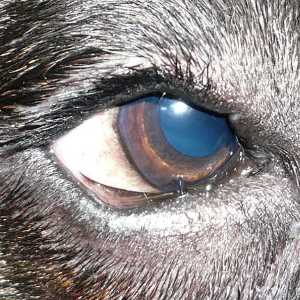 Distichiasis
DistichiasisAn eye condition that new owners should be aware of is Distichiasis. More serious damage to the cornea may develop over time. Distichiasis describes a condition in which eyelashes are abnormally located in the eyelid margin.
An extra row of eyelashes grow out of the base of
the meibomian gland, which is an oil gland on the eyelid margin. These eyelashes rub against the surface of the eye. If it is not treated, the constant rubbing on the eye leads to cornea ulcers. These extra eye lashes are seen in many breeds, particularly the long haired breeds, but it can occur in any dog.
Clinical signs of Distichiasis include tearing (in varying amounts), redness of
the conjunctiva, and inflammation and possible ulceration of the cornea.
Diagnosis can be made by your veterinarian.
Treatment: To treat, the veterinarian will remove the problem eyelashes and destroy the roots so they do not grow back. Cryotherapy or chemical freezing, or electrolysis is used in this procedure. Usually a specialist (veterinary ophthalmologist) performs these surgeries. If the eyelashes are just plucked out, they will grow back
In Shih Tzu, Distichiasis occurs with reasonable frequency. The hereditary basis has not been established, although it seems probable, due to the high incidence in some breeds.
Harderian Gland Prolapse (Cherry Eye)
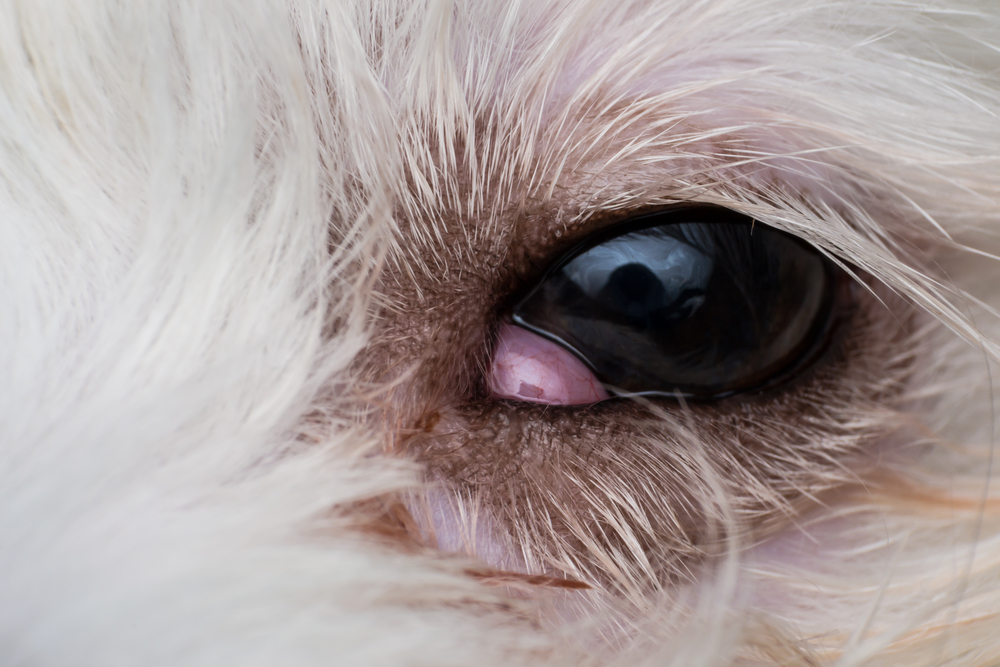 Harderian Gland Prolapse (Cherry Eye)
Harderian Gland Prolapse (Cherry Eye)Whether you believe that a cherry eye is a cosmetic problem
or a serious medical condition, you probably have to agree that a cherry eye
will never improve the appearance of a dog. Among the Shih Tzu eye problems, this one is perhaps the most unsightly.
Getting its name from the fact that it seems to resemble a bright red cherry, the correct medical term for this odd-looking mass is a prolapse gland of the third eyelid.
Unlike people, dogs have a third eyelid or membrane that contains the glands that produce tears. When the tissue that holds these glands weakens, they will pop out so what you see is a small mass, which looks like a cherry. Once the gland pop is out and visible, it can become swollen and even become infected.
You would think that a cherry eye is painful to the dog, but it usually not. The main problem that unfolds is the lack of adequate tear production to lubricate the eye, causing the dog to experience a dry eye.
Cherry eye is common in small dogs, especially young ones. Breeds with short muzzles such as boxers, bulldogs, pugs, and Boston terriers are more prone to developing this condition just as Shih Tzu dogs are.
There seems to be some disagreement as to whether it is a problem that needs to be fixed or simply a cosmetic issue causing the dog to have a rather peculiar appearance. There even seems to be controversy over whether the membrane should be removed or just tucked back into place.
Symptoms
The only symptom is the noticeable circular mass that protrudes from the side of the dog’s eye. It can occur in one or both eyes. Sometimes the mass is accompanied by swelling and irritation.
Cause
Since the condition seems to follow certain breed lines, it is likely an inherited problem. According to Dr. Karen Becker, the cause of cherry eye is not well understood. It is however believed to be weakness of the connective tissue ligaments that holds the glands in place. Since the condition seems to follow certain breed lines, it is likely an inherited problem.
Diagnosis
The veterinarian will make a diagnosis after observing the mass.
Treating Cherry Eye
Treatment options can fall into two categories: medical and surgical. Medical interventions sometimes work if they are begun immediately after the gland pops out. The veterinarian will prescribe eye drops.
If medical treatment fails, it is time for surgery. Veterinarians can either suture the gland back where it belongs or they can remove it entirely. If your veterinarian chooses to remove the gland, the dog may be susceptible to dry eye or Keratoconjunctivitis sicca or KCS , a chronic degenerative conjunctivitis. KCS can lead to vision problems and blindness. If this happens, the cornea dries out due to inadequate tears. Owners must apply eye drops daily to keep the eye lubricated; otherwise, the vision is likely to be affected in the eye.
Surgery is done under general anesthesia. Most of the surgeries to correct Cherry Eye are fast and have very few complications. Most animals go home the same day after they recuperate from anesthesia. After the surgery, some animals are prescribed antibiotic ointment to assist in healing, and prevent infection. Although prolapse can reoccur, it is less common nowadays than it once was.
Proptosed Globes
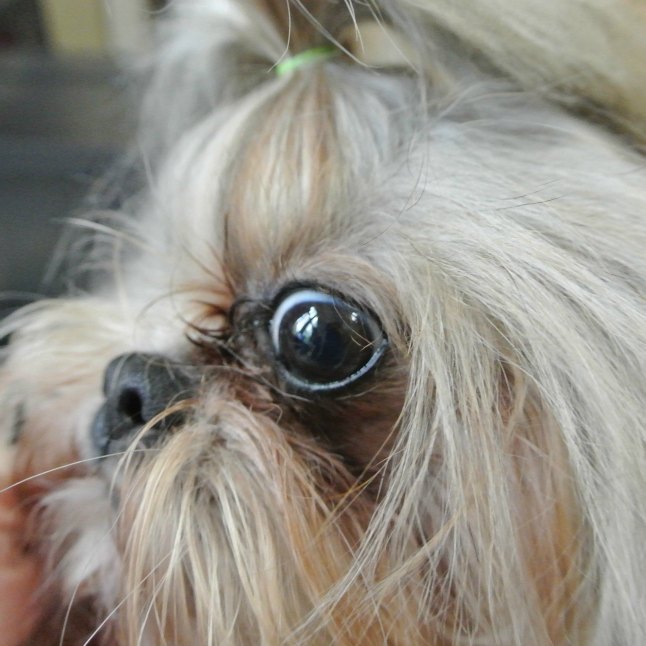 Zoey, Our Lovable One Eye Dog
Zoey, Our Lovable One Eye DogI will warn you that this can be scary and I say that through experience.
Proptosed globes are eyes that come out of their sockets.
Shih Tzu Dogs have small eye sockets and really large eyes.
Any head trauma can result in the loss of an eye.
About the last thing I had on my mind about Shih Tzu eyes was for one of my former show dog, Zoey to loose an eye in this way! In Zoey's case, it was the result of a nasty fight between her and our English Bulldog.
She came out the looser and the Bulldog--well, she just walked away without a scratch.
Our Zoey leads a perfectly normal life with only one eye. She is a lucky dog!
The veterinarian may be able to manipulate the eye back into place, but not always.
Approximately 40 percent of the proptosed eyes retain vision after being replaced in their globes.
Zoey is lucky she survived her ordeal with the Bulldog. But her eye did not survive. Sadly, one year later she got into a fight again, lost her eye and all vision. She never recovered and was put down in 2017.
Genetics play a huge part. Dogs whose eyes protrude more than others are not set in as deeply into their sockets.
There is no other prevention except to keep your dog away from any dog that would induce severe fighting and do not allow them to leave your home without a leash.
They should not be allowed to hang their heads
out of a moving vehicle or allowed to jump from high distances. I learned from this that many Shih Tzu Eye Problems are considered a medical emergency, but even with prompt care, sometimes, eyes cannot be saved.
As you can see, many of the Shih Tzu eye problems relate to injury and irritation to the eyes. Special care should be taken to keep hair and other debris from their eyes. Click here to learn more about caring for your Shih Tzu's eyes.
Trauma to the Eyes
Zoey's problems ended badly. She eventually lost both eyes and was unable to function without vision. We sadly had to put her to sleep after the last bout with eye problems. She was only 8 years old at the time. Now, we also had to deal with similar problems with her daughter, Dana, who also lost one eye. Dana has been lucky. She's survived with one eye now for seven years. But it has not been without problems. Keeping that one eye safe and healthy has been very difficult and has resulted in daily eye care the helps prevent dry eye from occurring with her only remaining eye.
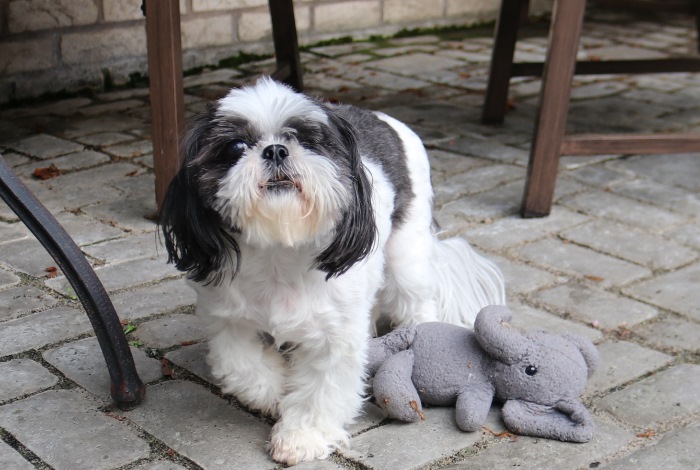 This is Dana, my one-eyed Shih Tzu. It's actually difficult to see immediately that she doesn't have two eyes.
This is Dana, my one-eyed Shih Tzu. It's actually difficult to see immediately that she doesn't have two eyes."Hi, I'm Janice Jones, a former veterinary technician and Shih Tzu expert with over 40 years of experience with the breed. Through Miracle Shih Tzu, I combine my medical background and extensive breed knowledge to provide reliable, practical advice for Shih Tzu owners. My mission is to help you give your Shih Tzu the happiest, healthiest life possible through evidence-based information and real-world solutions. Whether you're new to the breed or a seasoned owner, you'll find trusted guidance here for all aspects of Shih Tzu care.
I hold an undergraduate degree in Psychology with a minor in biology, Early Childhood Education, and Nursing, and a Master's in Mental Health Counseling.







